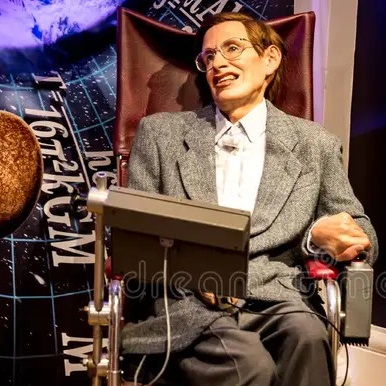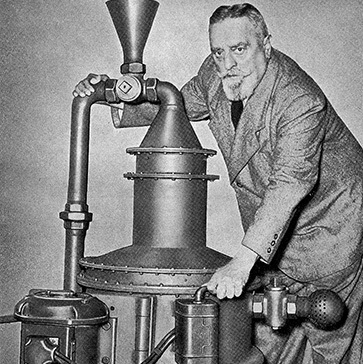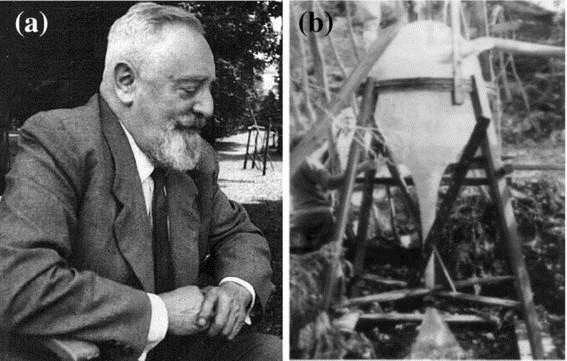Who was Viktor Schauberger?
Viktor Schauberger was an Austrian forest caretaker, naturalist, philosopher, inventor and pseudoscientist.
Viktor Schauberger was born on June 30th,1885 in the parish of Ulrichsberg, in Upper Austria. He was descended from a long line
of foresters, who had devoted their whole lives to the natural management and administration of the forest, a dedication mirrored
in their family motto, ‘Faith in the silent forests’. With this as his background and much against his father’s will, but with the support of his mother, at the age of 18 he flatly refused to follow in the footsteps of his two elder brothers and attend university, having seen how it had affected his brothers’ thinking. Apart from his earnest desire to become a forester,the main reason for his refusal was that he did not wish to have his natural way of thinking corrupted by people he considered totally alienated to Nature. He did not want to be forced to see things through other jaundiced eyes, but through his own. For, as he later wrote:
The only possible outcome of the purely categorizing compart-mentality, thrust upon us at school, is the loss of our creativity. People are losing their individuality, their ability to see things as they really are and thereby their connection with Nature. They are fast approaching a state of equilibrium impossible in Nature, which must force them into a total economic collapse, for no stable system of equilibrium exists. Therefore the principles upon which our actions are founded are invalid, because they operate within parameters that do not exist.
Our work is the embodiment of our will. The spiritual manifestation of this work is its effect.
When such work is done properly, it brings happiness, but when carried out incorrectly, it assuredly brings misery.
Taking his mother’s advice and following his natural instincts, Viktor became a junior forest warden, spending the next few years often in areas of remote forest. There he was able to perceive movements of energy and natural phenomena in Nature’s own laboratory, because in Austria in the early part of this century, circa 1900-1915, there were large tracts of forest still untouched by human hand. After the 1914-1918 war in which he was wounded, Viktor returned to forestry, eventually entering the employ of Prince Adolph zu Schaumburg-Lippe, the owner of a large hunting and forestry reserve in Steyrling.
In these districts there had been no interference in the balance of Nature and Viktor was thus able to observe events that are today inconceivable, and which no longer take place because of the enormous deterioration of the environment.
It was here that he acquired the insights into the natural movement
of water that resulted in the building of his first log flume.Here too he first became aware of other levitational energies inherent in water, for one day in the middle of a very cold winter, as he was about to cross over a fast-flowing mountain stream, he flushed a stationary trout from its lair as he sought a firm hold for his staff on the stream bed. Its lightning flash upstream immediately caused a number of questions to race through his mind:
How did the trout actually manage to get to this spot – and later I saw dozens of them in the same stream – which was cut off by a 60 metre high waterfall about a kilometre downstream, where the water was atomised into a veil of mist?
How was it able to flee upstream like a streak of greased lightning in mockery of all the laws of gravity?
How was it possible for this fish to stand so motionlessly, only steering itself with slight movements of its tail-fins, in this wildly torrential flow, which made my staff shake so much that I could hardly hang onto it?
What forces enabled the trout to overcome its own body-weight so effortlessly and quickly and at the same time overcome the specific weight of the heavy water flowing against it?
Why didn’t the water freeze even during periods of severe frost with temperatures below -30oC?
While Viktor undoubtedly had an especial talent for observation, a penetrating power of perception undimmed by preconceptions, he also developed what might be called an active consciousness, an ability to go beyond the merely visual in search of what lay behind a given phenomenon.
This taught him a great deal and how this ability gradually evolved, he explained as follows:
The Schaubergers’ principal preoccupation was directed towards the conservation of the forest and wild game, and even in earliest youth my fondest desire was to understand Nature, and through such understanding to come closer to the truth; a truth that I was unable to discover either at school or in church.
In this quest I was thus drawn time and time again up into the forest. I could sit for hours on end and watch the water flowing by without ever becoming tired or bored. At the time I was still unaware that in water the greatest secret lay hidden.
Nor did I know that water was the carrier of life or the source of what we call consciousness.
Without any preconceptions, I simply let my gaze fall on the water as it flowed past. It was only years later that I came to realise that running water attracts our consciousnesses like a magnet and draws a small part of it along in its wake. It is a force that can act so powerfully that one temporarily loses one’s consciousness and involuntarily falls asleep.
As time passed I began to play a game with water’s secret powers; I surrendered my so-called free consciousness and allowed the water to take possession of it for a while. Little by little this game turned into a profoundly earnest endeavour,because I realised that one could detach one’s own consciousness from the body and attach it to that of the water.
When my own consciousness was eventually returned to me, then the water’s most deeply concealed psyche often revealed the most extraordinary things to me. As a result of this investigation, a researcher was born who could dispatch his consciousness on a voyage of discovery,as it were. In this way I was able to experience things that had escaped other people’s notice,because they were unaware that a human being is able to send forth his free consciousness into those places the eyes cannot see.
By practising this blindfolded vision, I eventually developed a bond with mysterious Nature,whose essential being I then slowly learnt to perceive and understand.
Schauberger’s ideas and discoveries
1-Viktor used to spend hours watching fish in the streams. He was fascinated by how the trout could lie motionless in the strongest current and then, if alarmed, without warning, would dart upstream rather than be carried down with the flow. Having learned from his family about the importance of temperature on the energy potential of water, he did an experiment. He had colleagues heat up 100 liters of water that, on his signal, they poured into the fast-flowing mountain stream some 150 meters upstream from where he stood. Viktor noted how the trout he had been observing became agitated, and soon was unable to hold its station in the fast flowing stream, thrashing its tail fins to no avail. The minute, but nevertheless abnormal, rise in the average temperature of the water and the chaoticized flow that resulted, had interfered with the trout’s hovering ability.
He would often quote these experiences with the trout as having the most influence on developing his ideas, for temperature and motion were the foundations of his theories and discoveries. He subsequently developed a generator to produce energy directly from air and water, naming it the ‘trout turbine’ in honour of his mentor, though it was later called the ‘implosion machine.’
Viktor’s abiding interest was to discover how to generate energy using Nature’s own methods. He worked out how a trout is able to screw its way up a waterfall by hitching a ride on strong levitative currents, and using this principle, the first generator he developed was the ‘trout turbine.’ To perfect this he needed more precise information on how a trout is able to stand motionless in a fast moving current, and indeed how it can suddenly accelerate upstream. The above diagram illustrates this amazing phenomenon .
The trout is holding its station in mid steam where the water is coldest, densest and has most potential energy. Viktor studied the gills of the fish and found what he thought were guide vanes which would direct the water flow into a powerful backwards vortex current. Its shiny scales minimize friction with the water, but they also create scores more of little vortices that amplify the upstream counter current, particularly towards the tail, which cancel out the pressure on the fish’s snout. A zone of negative thrust is created along the whole of the trout’s body and so it stays in the same place. These counter currents can be increased by flicks of the tail, creating negative pressure behind the fish. Flapping of the gills amplifies the vortices along its flanks, giving it a sudden push upstream. The faster the gills move the more oxygen-deficient water is expelled from the body. This combining with the free oxygen in the water, causes the water body to expand, with an effect on the fish similar to squeezing a bar of wet soap in your hand.
2-Another experience that Viktor often quoted as significant for his growth in understanding, occurred when he had shot a chamois buck on a frosty night under the full Moon. The buck fell into a ravine and, attempting to retrieve it, Schauberger fell down a snow chute to the bottom. In the bright light of the Moon, he became aware of movement in the stream below where he stood. Some green logs were bobbing up on the surface, then sinking to the bottom, as though they were dancing. And not only that, but a large stone began to gyrate at the bottom, and then came to the surface, where it was immediately surrounded by a halo of ice. Other stones also surfaced, and he saw that they were all egg-shaped. It seemed that no uneven or ragged stones would float in this way. Schauberger developed his ideas of different forms of motion and shapes from these observations.
Having seen how water could carry its greatest load on a cold, clear night, he made practical use of this observation. During the winter of 1918, the town of Linz was suffering a severe shortage of fuel as a result of the war when the draft animals had been commandeered. There was a small stream that ran through narrow gorges and which was considered unsuitable for transporting logs, but he wanted to try out his ideas using this stream. His offer to help being accepted by the authorities, he describes how he proceeded:
I had observed that an increased water level after a thaw builds up sandbanks that are then partially dispersed when the water temperature drops during clear cool nights. I then waited for an increase in the strength of the water current. This takes place in the early hours of the morning, when it is coldest, and particularly at full Moon, although the volume of the water is apparently less due to its compression on cooling. I planned for the timber to be put in the stream under these conditions, and in one night 1600m3 were brought down to the valley.
Viktor had discovered that when water was at its coldest, it had much more energy that enabled it to carry more sediment, gouging out deposits of sand, and concluded that in these conditions it would be able to carry a greater weight of logs. This was a principle that enabled him to turn upside down the current theories of hydraulics, and particularly the methods of river and flood management.

He also became very interested in the behaviour of trout and salmon in the mountain streams. The large mountain trout could lie motionless for any amount of time in the strongest current They made the odd movement with fin and tail, but otherwise appeared anchored in the rushing flow. If alarmed, on the other hand, they darted at lightning speed against the current instead of allowing themselves to be carried downstream by it, which would seem to be more natural.
Schauberger could find no explanation for the trout’s behaviour in existing literature. However, he knew a mountain stream was colder near its source and became warmer farther from the source. Could this have some connection with the trout’s struggle to escape against the current? He undertook several experiments to investigate this. As his observation point he chose a stretch of strong rapids along a stream where a large trout liked to lie. He men organised his woodsmen to warm up about one hundred liters of water and pour this in 500 meters upstream at a given signal. The stream was large, with a flow volume of several cubic meters of water per second. The meagre 100 liters of heated water did not noticeably warm up the stream. However, soon after the warm water was added, the trout- which until then had remained motionless- became greatly agitated. It flexed its tail, and was only with considerable effort able to maintain its position with vigorous movement of its fins. Soon its efforts were to no avail, and it was swept downstream, out of sight only much later to return to its old position. This convinced Schauberger that his theory was correct that there was indeed a connection between the water’s temperature and the trout’s behaviour.
3-Schauberger also studied the trout’s ability to jump up high waterfalls with little apparent effort. Within this phenomenon he saw evidence for his theory that the trout exploited some hitherto unknown source of energy within the water. He can himself describe such an observation:
It was spawning time one early spring moonlight night I was sitting beside a waterfall waiting to catch a dangerous fish poacher. What then occurred took place so quickly that I was hardly able to comprehend. In the moonlight falling directly onto the crystal clear water, every movement of the fish, garnered in large numbers, could be observed. Suddenly the trout dispersed, due to the appearance of a particularly large fish which swam up from below to confront the waterfall. It seemed as if it wished to disturb me other trout and danced in great twisting movements in the undulating water, as it swam quickly to and fro. Then, as suddenly, the large trout disappeared in the jet of the waterfall which glistened like falling metal. I saw it fleetingly under a conically-shaped stream of water, dancing in a wild spinning movement the reason for which was at first not clear to me. It then came out of this spinning movement and floated motionlessly upwards. On reaching the lower curve of the waterfall, it tumbled over and with a strong push reached behind the upper curve of the waterfall. There, in the fast- flowing water, with a vigorous tail movement it disappeared. Deep in thought I filled my pipe, and as I wended my way homewards, smoked it to the end. I often subsequendy saw the same sequence of play of a trout jumping a high waterfall. After decades of similar observations, like rows of pearls on a chain, I should be able to come to some conclusion. But no scientist has been able to explain this phenomenon to me.
4-Schauberger, in another connection, suggests that a natural watercourse allowing natural motion, builds up an energy that flows in the opposite direction to the water. It is this energy that is used by the trout. In a suitably formed waterfall this energy flow can be distinguished as a channel of light within the streaming water. The trout seeks out this energy flow, and is sucked upwards as if in a whirlwind.
It was not only the trout, however, that he saw move in such an unusual way in these undisturbed waters. On a clear late winter night, in brilliant moonlight, he stood by a mountain pool formed within a rushing stream. The water in the pool was several meters deep, but so clear that he could easily see the bottom. Here lay stones, some as large as a man’s head. As he stood studying these, he was surprised to see mat a few of the stones were moving here and there, colliding with each other as if pulled together, only to be forced apart as if electrically charged. He explains:
I did not trust my generally observant eyes any more, when suddenly an almost head-size stone began to move in a circular path in the same way as a trout before leaping over a waterfall. The stone was egg-shaped.
In the next instance the stone was on the surface of the water, around which a circle of ice quickly formed. It appeared to float on the water surface, lit by the full moon.
Then a second, a third, followed by other stones in sequence went through the same movements. Eventually nearly all the stones of the same egg shape were on the surface. Other stones of irregular or angular shape remained below and did not move. At the time I naturally had no idea that it was a case of a synchronicity of events, leading to a unique form of movement This movement overcomes the force of gravity and allows the stones of regular shape to come to the surface of the water.’
Schauberger says later that all the ‘dancing stones’ contained metals. It was such observations as these in his wilderness that caused him to ponder over the meaning of ‘motion’.
He asked himself: ‘What, in fact, is ‘motion’?’ Are there perhaps different types of motion? Might there possibly exist a form of motion as yet unknown to science? Out of his ponderings and observations there slowly grew a theory of the different forms of motion. He dearly wanted to put forward this theory, to discuss it with technical experts and scientists, but how was he to show that he had discovered something new?
The Trout
5-Two questions shot through my mind. Firstly, how do trout reach this high location, because a kilometer downstream the water plunges 60 meters (180ft) and is atomised into a veil of mist? Secondly, just how was it possible that there, right in the axis of the current, a large number of fish were able to stand so effortlessly motionless. They steered themselves with but slight movements of their tail-fins, both overcoming their own weight and the specific weight of the heavy water flowing against them?
In this way I discovered the animalistic magnetism of earth, sap and blood, which enables the naturally flowing, planetarily inward-spiralling water-masses to maintain their steadiness of flow in variable gradients. This steadying force is rendered inoperative if the watercourse is regulated and straightened out. It is also extinguished if springwater is centrifuged in high-speed, steel pressure-turbines.
It seemed as though the trout was rocking itself to and fro in strongly pronounced looping movements. It was dancing a sort of reel in the swirling water. All at once it disappeared under the fall of water, which fell like liquid metal into the pond. The trout suddenly stood up on its tail and in the conically converging stream of water I perceived a wild movement like a spinning top, the cause of which was not immediately apparent. Having temporarily disappeared, the trout then re-emerged from this spinning movement and floated motionlessly upwards. Upon reaching the underside of the topmost curve of the waterfall it did a quick somersault in a high curve upstream and with a loud smack was thrown beyond the upper curvature. With a powerful flick of its tail-fins it disappeared.
6-Later on I often saw how trout playfully surmounted high waterfalls, in this case 6 meters (19ft) high. How and why they were able to do this, however, I only discovered years later as a result of other observations which happened one after the other like a string of pearls. No scientist was ever able to explain this phenomenon to me.
I scared a large trout from its lair where it is able to feed and rest without effort. As if no law of gravity existed and as though shot from a bow, the trout darted upstream like lightning. Two questions flashed into my mind just as quickly as the trout sped upstream.
One: How did this trout actually get to this spot (later I saw dozens of them in the same stream) which was cut off by a waterfall about 100 meters high roughly a kilometer downstream?
Two: What forces enabled the trout, not only to overcome its own body- weight so effortlessly and quickly, but also to overcome the weight of the water flowing against it?
Many years later I finally understood the cause of this phenomenon. It is the ‘cycloid-spiral space-curve’. In conjunction with reactive differences in temperature it achieves the incredible; the overcoming of all weight through the creation of a reactive counterweight, generally known as the ‘specific weight’. It is necessary to understand this concept as a condition of densation pertaining to higher, more etherealised and more energetic formative entities, already in a metaphysical state of being.
Water, source of life
7-His painstaking and inspired studies of water were the source for a seminal paper that Schauberger wrote on ‘Temperature and the Movement of Water.’ Central to these was the influence of minute differences in temperature, which are presently wholly ignored by modern hydraulics and hydrology. Natural, living, water, which is conventionally regarded as a homogenous substance, he showed to be composed of many strata or layers with subtle variations in temperature and electric charge which influence the water’s motion, its form of flow and its physical properties.
Schauberger saw water as a pulsating, living substance that energizes all of life, both organic and inorganic. He called it ‘the life blood
of the Earth.’ Whether as water, blood or sap (which are essentially water), it is the indispensable constituent of all life-forms, and its quality and temperature is fundamental to health. When it is healthy it has a complex structure that enables it to communicate information, carry energy, nutrients and healing, to self-cleanse and discharge wastes. He believed that one of the causes of the disintegration of our culture is our disrespect for and destruction of water, the bringer of life, for in doing so we destroy life itself.
8- Viktor also profoundly believed that our dangerous technologies produce poor water that has lost its energy and its ability to pulsate — and is effectively lifeless. This dead water produces inadequate nutrition, and Viktor believed that its regressive energies are responsible for degenerative diseases like cancer, for lower intelligence and for community turmoil.
Natural forests (not the monoculture plantations of today) are the cradle of water and also the main source of oxygen for the planet. Their precipitate destruction, Schauberger predicted, would result in global warming, severe water shortage and the creation of deserts. He made brilliant observations of the way in which trees in a natural, diversified environment are biocondensers of energy (accumulating and storing energy from both Sun and Earth) — how the groundwater (man permitting) brings Earth’s energy to the tree in order to balance the Sun’s energy.
Hydroelectric power
9-Present methods of hydroelectric power generation destroy water in their own way. The water is thrust down cylindrical pipes under enormous pressure. Upon leaving these it is then hurled against steel turbine blades where it is smashed to smithereens. The physical structure of the water is literally demolished and all the dissolved oxygen, and even some of the oxygen in the water molecule itself, is centrifuged out of the water. Viktor Schauberger had photographs taken through a microscope that show the marked difference in the structure of water that has been subjected to centrifugence on the one hand and centripetence on the other. The fragmented appearance of the centrifugally moved water is unmistakable. The slicing action of the blades causes severe friction and heating which makes the oxygen highly aggressive and it attacks the bare metal, severely pitting the surface, often destroying the blades’ efficiency.
This fragmented and largely oxygen-deficient water, a virtual skeleton of healthy water when forcibly expelled into the river, has disastrous consequences for the fish and other aquatic life. Inevitably certain species of fish disappear once these power stations are commissioned, and other forms of life survive with difficulty.
The water is so depleted that it has to build itself up again completely before it can be of any benefit to the environment. So it seeks out new supplies of oxygen and other high quality substances wherever it can find them, including living things. With their particularly intimate contact with this ‘ravenous’ water, fish are especially prone to attack as it enters their very delicate gill systems and their body’s tissues are attacked by oxygen-hungry carbones. The soil bordering on the river is also leached of its nutrients which the water hungrily consumes resulting in a large drop in soil fertility and productivity.
Experimental egg-shaped vessel for generating hydro-electric power
10-The hyperbolic cone device with spiralled nozzles to maximize speed of water flow. This could produce 90% more electricity than a hydro turbine.
Viktor Schauberger showed how unnecessary is this extraordinarily destructive power-generating process. He devised a novel method in the early 1920s which can produce 90% more electricity from a given flow-volume without harm to the water. Using water from a nearby stream Viktor installed this device to light his forest warden’s house, which was too remote to be connected to any other source of supply.

It operates by water being cooled, densified and energized as it passes through a rifled brass nozzle, in a vortical flow, thereby reducing both pressure and friction as the water is centripetally drawn away from the sides. The water is directed against a multiple- spiral, shell-like impeller attached to the shaft of a generator.
The wooden water main
11-Schauberger knew that water can maintain its vitality and energy only if it is allowed to tumble about in a spiralling vortical manner. So in 1930 he set about designing a pipe that would actually encourage this movement. It was constructed of wooden staves, like a barrel, which allowed the moisture to seep through, transferring a cooling effect (as in sweating) to the water in the pipe. The spiralling movement was created by a series of guide vanes, which act like rifling in a gun barrel. These were made of silver plated copper to enhance the subtle energies and fluted so as to direct movement towards the center, thus reducing the heating effects of friction.
It is a brilliant design that imitates the natural pulsating flow of water in a natural vessel and which delivers water that purifies itself and cools through its motion, eliminating the need for any sterilizing or purifying additives. Ideally, these wooden water mains should be embedded in sand, allowed them to breathe, and protected from light and heat. In such conditions they should out- last a steel pipe.
Schauberger’s search for free energy
12-Schauberger abandoned the Euclidean model of straight line and circle. All the functional surfaces of his machines employ the spirals, sinuosity and curves of the open forms of non-Euclidean geometry that are found in Nature. The egg-shapes and spirals that he employed produced life-affirming energies that stabilize, enhance and rehabilitate natural processes.
When Schauberger designed his prototype machines it was extremely difficult to perfect complex curvilinear surfaces. Now, with computer programmes, it is possible with ease to replicate Nature’s eggs, spirals and vortices. A design breakthrough to designing benevolent systems would be theoretically simple; what is lacking is the insight and the imagination.
During the 1930s and 1940s, he developed a number of prototypes of a machine which produced high quality spring water, a domestic air conditioning appliance, and various machines which produced prodigious amounts of motive power. All these machines worked on much the same principles, and had in common a virtually silent and inexpensive operation. All the important elements of Nature’s repertoire come into their own, such as male and female ethericities, creative vortical movement, temperature gradients, bioelectricism and biomagnetism. As Schauberger commented: At the intersection of two temperature gradients atomic energy is released. Whether it is a formative or destructive energy is deter- mined in each case by the type of movement and the composition of the alloys used to build the motion-producing machine.’
13-It was proved conclusively already by Viktor Schauberger to the famous hydrologist Prof. Forcheimer that when a stream of water is deflected tangentially by a stone of a certain shape and composition, and no larger than a child’s head, the temperature of the water drops by 0.1 to 0.5° C. Such a temperature drop can reduce the temperature of one cubic liter of water 0.1° C. and is equivalent of 42.7 mkg effective power. The same is true of a temperature increase. In summer, to raise the temperature of a river such as the Danube (delivery about 800 cubic meters/second), for example, to 20° C. bathing temperature, it takes about 60 million PS or 45 million KW. This energy is freely supplied by the sun. We know that as it is being heated the water loses much of its natural properties, becoming first undrinkable, then dead, and finally putrid. In contrast, cooling to the point of anomaly +4° Centigrade, by imparting to it a spiral motion, restores its original properties, so it becomes once more like fine spring water.
After a while Schauberger discovered that Forcheimer was different to the scientists he had met earlier. The two men stood beside a mountain stream, deep in discussion. Suddenly Schauberger said:
‘Can the Professor tell me where the water is coldest, before or after it has flowed around that stone?’ – and he pointed to a stone out in the stream, which had been worn away to a particular shape. ‘There is not the slightest doubt that the water is colder before it has passed the stone’, answered Forcheimer, and then he began to explain how the friction against the stone increased the water temperature. ‘Com- pletely wrong’, replied Schauberger. ‘The water is colder below (i.e. downstream from) the stone.’
A forceful debate ensued and Forcheimer drew up flow charts and temperature diagrams in the sand on the stream bank to emphasize that he was right. After a while Schauberger said:
‘Would it not be simpler if we measured the temperature of the water to see who is right?’
He had a thermometer with him and strode into the water in his leather breeches. When he had taken the temperature he accounced triumphantly to the impatient Professor that the water below the stone was 2/10°C colder than above.
THE REGENERATION OF DISEASED WATER
14-Schauberger’s discoveries prove among others that water can be multiplied and improved by applying planetary motion and simply imitating nature’s methods, and conversely that when water is ruined by centrifugation and such devices as compressor turbines, water wheels, etc., it becomes devitalized, loses its power of levitation, ceases to breathe, asphyxiates and — with continued exposure to sunlight — recedes and vanishes altogether. Of course, in the bosom of Mother Earth this diseased water is gathered up again and its polarity reversed, whereupon it is re- generated and ready to reappear as a fresh and bubbling mountain spring at a new place, where it still finds the protective shade of trees it requires.
Be that as it may, our supplies of fresh water are steadily shrinking. In various branches of industry water experts worry and desperately search for a solution to the water problem. This search is bound to be fruitless unless they turn to Schauberger’s discoveries and replace the present fire technology with a bio- technology that will protect and benefit life.
The water and the energy problems can be solved simultaneously if magnetism is produced by mechanical means, and all attempts to produce atomic energy are abandoned.
People can learn only by trial and error. Perhaps the error we made in applying fire methods indiscriminately was necessary to make us realize how dangerous it is to reverse and alter the natural basic motion (the one indicated by Nature as our only means of development) and how wrong it is to employ combustion and other destructive processes to build a civilization. This explains the decadence of our culture. When people use only excentric or centrifugal forces for technical purposes they deteriorate both morally and spiritually.
To use nuclear energy produced by the explosion and fission of atoms is a fatal blunder and a crime against humanity and against the earth itself. Hence it is only natural that the branch of science which has conjured up these horrors has found itself in a blind alley from which there would be no escape were it not for the discovery of diamagnetism, this universal life force without which there can be no respiration and no life. Fortunately, it can be mechanically produced and used to give earth, air and water the chance to breathe again.
The most convincing and obvious proof that life is gradually perishing can be found in the streams and rivers of our industrial areas were water is already so polluted by industrial waste waters and sewers that it resembles drainage from a manure pit. As a result our underground water and supplies of drinking water are gradually becoming unfit for human consumption. They are killing people, just as they have killed the fish which only a few years ago used to splash in them. Water chlorination is also harmful to the human organism. Today the Rhine and the Weser are Europe’s most polluted rivers.












